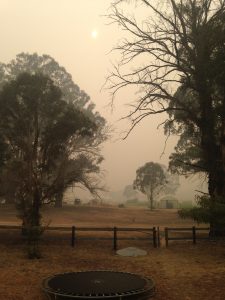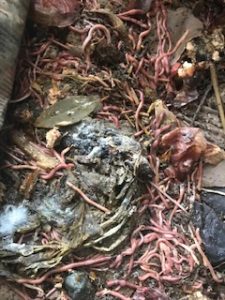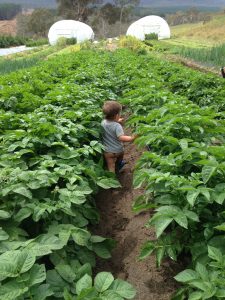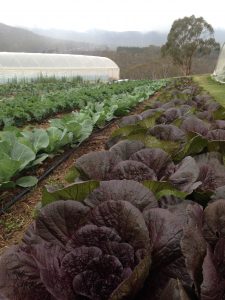If you don't already have a worm farm, why not? I'm not going to tell you how to set one up in detail, as there are plenty of great books and articles on that. This is more of a riff on worm farming from someone who used to be a bit bah-humbug about them but is now utterly reformed and ready to sing their praises to anyone who'll listen.
 Let's start by imagining a wobbly movie fade back to about November 2019. Everything was hot and crunchy and we could see the giant funnel of smoke from the North Black Range fire burning to the East of Canberra from every direction. It was a scary time. The drought leading up to the fires was relentless. It got to the point where I couldn't read story books to my kids about rain because they made me too emotional (one I remember particularly was a Peppa Pig book where Peppa complains about having to have a rainy day inside. I have had a distinct dislike for that whinging little pig ever since!). Everything felt lifeless, the trees were dying, the frogs were silent. I needed something vital and hopeful, and a worm farm felt like a little box of life-source in all the brittle dust. It was also a transportable piece of the farm throughout the many evacuations that were to come that summer. I knew that if the farm burned I could bring it back to life with the contents of that worm farm and my crates of seeds.
Let's start by imagining a wobbly movie fade back to about November 2019. Everything was hot and crunchy and we could see the giant funnel of smoke from the North Black Range fire burning to the East of Canberra from every direction. It was a scary time. The drought leading up to the fires was relentless. It got to the point where I couldn't read story books to my kids about rain because they made me too emotional (one I remember particularly was a Peppa Pig book where Peppa complains about having to have a rainy day inside. I have had a distinct dislike for that whinging little pig ever since!). Everything felt lifeless, the trees were dying, the frogs were silent. I needed something vital and hopeful, and a worm farm felt like a little box of life-source in all the brittle dust. It was also a transportable piece of the farm throughout the many evacuations that were to come that summer. I knew that if the farm burned I could bring it back to life with the contents of that worm farm and my crates of seeds.
I wasn't great at worm farming at first. I made the number one rookie mistake you can make with a worm farm -I fed the worms too much. With too much food came tiny flies which would emerge in a furious cloud whenever I lifted the lid of the farm and fly into my nose and throat, making me stagger backwards coughing and spluttering like I was in some kind of grainy black and white 'before' footage on a late night infommercial. Then there was the foul smelling slimy liquids and other horrid little wriggly things that also took up residence. I needed to slow down and observe the whole process more closely in order to understand the kind of habitat I was trying to create (observation is the ultimate teacher when it comes to working with nature).
According to Nicole Masters, author of For the Love of Soil and all round regenerative agriculture QUEEN, 'the perfect worm farm makes no liquid'. Masters often jokes that when she tells people that the liquid that comes out the tap at the bottom of the worm farm is not liquid gold (and may actually be making their plants sick), they react like she has told them their children are ugly.
It turns out worm farms aren't a cute and magical little garbage dump for all your kitchen scraps. After my disappointing discovery that my 'children' were ugly I read up on feedstock, carbon to nitrogen ratios, bedding materials, moisture, temperature and feeding rates. I learned that worms need to be fed at a steady rate, they need moisture but not too much, they don't want to be boiled or frozen (just like us) and they need bedding material rich in carbon (we use plain, brown corrugated cardboard but newspaper or wood chips work too). I learned to think of worm farming less as 'feeding the worms' and more as trying to manage an ecosystem in a box -similar to the floor of a healthy forest.
These days I am a happy mother to four worm farm children and have an intuitive feel for how the worm farms need to look, feel and smell to be healthy. Far from bah-humbug, I must confess that these days my obsession knows no bounds (including any personal boundaries my family may have) and these four worm towers live right in my lounge room. And yes, I know you are wondering, my children are BEAUTIFUL. They produce zero smells, zero liquid and are active enough that when the evening is finally quiet (because my real children are in bed)I can hear them slurping away in their boxes.
So I obliterated kitchen scraps and boxes from Booktopia. But what else? Well, our worm farms also play a crucial role on our farm. Worm castings (the poo) are the best available source of plant available nutrients, vitamins, enzymes, natural antibiotics, plant growth hormones and humic acids you can get for your garden. They're also full of good critters like protozoa and nematodes. Many (if not most) agricultural soils are devoid of these larger soil organisms which are necessary for nutrient cycling. (It was hardly a scientific survey but I may have used one of my essential shopping trips during lockdown to scratch a bit of dirt off a woolies potato and put it under the microscope. Suffice to say it was a sad state of affairs.)
 On our farm we use the castings liberally, and in favour of any product we could buy off the shelf. We mix solid castings through our seed raising mix and use it to inoculate biochar. We make a simple extract (by agitating the castings in a bucket of water for 5 minutes of so) which we use as a foliar spray to provide nutrition and help protect plants against disease. Worm castings are rich in pseudomonas fluorencens, an organism which eats ice crystals that form on leaf surfaces so these foliar sprays also assist in protecting our plants from frost damage.
On our farm we use the castings liberally, and in favour of any product we could buy off the shelf. We mix solid castings through our seed raising mix and use it to inoculate biochar. We make a simple extract (by agitating the castings in a bucket of water for 5 minutes of so) which we use as a foliar spray to provide nutrition and help protect plants against disease. Worm castings are rich in pseudomonas fluorencens, an organism which eats ice crystals that form on leaf surfaces so these foliar sprays also assist in protecting our plants from frost damage.
If you're feeling down about the state of the world I heartily recommend starting a worm farm. It's like turning literal rubbish into magic. For free. And if you're not convinced by now, I'm not sure how to help you.

